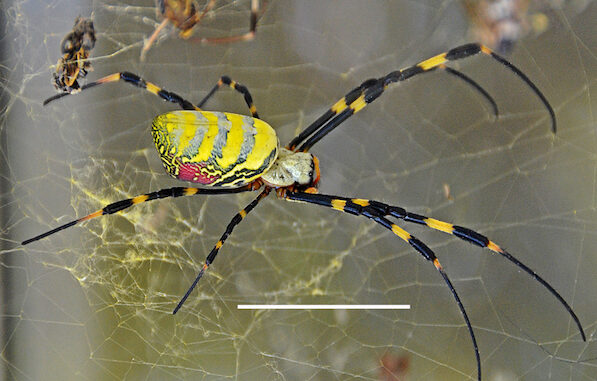
First it was armadillos and nutria rats, then hammerhead worms and “murder hornets” – and now, flying spiders.
Invasive Joro spiders with four-inch-long legs and a habit of spinning webs for flying have been making national headlines in recent days, leading to viral social media posts and near-hysteria in some communities in Northeastern States. N.C. State University reports that the spiders have been in the United States for years, and are slowly making themselves at home across the eastern seaboard, after having been accidentally imported in Georgia.
Joros are similar to common garden orb weavers – often called “Charlotte Spiders,” from the beloved children’s book and movie – but they are significantly larger. The average orb spider has legs two to three inches in length, while Joros can have legs four inches or longer. Both spiders have black and yellow markings, smooth skin and spindly legs.
The spiders also migrate by spinning webs that allow them to “fly” (technically float) for miles.
As if a flying spider wasn’t enough for most arachnophobes, Joros are also venomous. Joros also have extremely small mouths, making it difficult for them to bite a human, even if they are so inclined. Their venom is not as poisonous as the average fireant bite, and is not generally used as a weapon. Bites are instead used to immobilize prey caught in the spider’s intricate webs.
The good news is that their bites are harmless to humans, according to entomologists at N.C. State and the University of Georgia (UGA).
The East Asian Joro Spider (Trichonephila clavate) apparently first turned up in Georgia around 2013. The species is native to Japan, Korea, Taiwan and China, and like fireants and other invasive bugs, hitched a ride to America via shipping containers.

Amitesh Anerao and Andy Davis of the University of Georgia recently published a study of Joro spiders.
Their UGA study found that Joro spiders actually freeze when they encounter humans, and will try to retreat. Participants in the study used turkey basters to blow puffs of air on Joros, and after freezing in place for anywhere from ten seconds to an hour, the spiders fled.
“They basically shut down and wait for the disturbance to go away,” Davis said in the study. “Our paper shows that these spiders are really more afraid of you than the reverse.”
UGA and NCSU both note that Joros are not especially competitive with native species of spiders. They eat insects and on rare occasions, the spiders kill and eat small birds that get caught in a larger Joro web.
Joros also like to eat cockroaches and Palmetto bugs, which may explain why they adapt very well to urban environments where ordinary orb weavers have slimmer pickings in terms of prey. Because they freeze when confronted by noise or activity, the paper says they can conserve energy, thus allowing them exist in busier urban environments.
Their webs, however, can be large — Joro spider webs have been documented between power lines and across canopies at gas stations.
Both universities say the spiders are here to stay.
“One thing this paper tells me is that the Joros’ rapid spread must be because of their incredible reproductive potential,” Davis said. “They’re simply outbreeding everybody else. It’s not because they’re displacing native spiders or kicking them out of their own webs.”
Since 2022, sightings of Joros have been reported to NCSU from western North Carolina, but entomologists say the spiders’ high birth rate and adaptability mean it will eventually spread statewide. Biologists are asking for sightings of Joros spiders to be reported to cooperative Extension or the N.C. State Plant Disease and Insect Clinic. They do ask that you be sure you are not reporting the common golden orb weaver or other species that resembles Joros.
Unlike native orb weavers, Joros do not typically have the telltale crosshatch pattern in their webs that is a hallmark of “writing” spiders.
For more information, go to https://homegrown.extension.ncsu.edu/2022/06/joro-spider-just-the-facts/
























